Scaled Agile Framework (SAFe) for Lean Enterprises: An Overview

In a perfect world, complex software projects run themselves: development and testing are in synergy, time is not an issue, and product specifications never change. But if you’re reading this article, you believe in fairytales no more than we do. You’ve also probably heard of or worked with the Agile model in one of its forms, and it’s been a good fit. But this time, it’s different: your enterprise is growing rapidly and may soon employ hundreds of people. You simply can’t take any chances when choosing the right process.
Relevant Software has been successfully using Agile for years, and we can say with confidence: the Scaled Agile Framework (SAFe) is the go-to solution for large enterprises when it comes to scaling software teams and lean product development.
Do you think SAFe could be the right tool for your next project? Let’s learn more about it, so you can make an informed decision.
What is the Scaled Agile Framework
According to the 14th Annual State of Agile Report, 70% of companies working with Agile mention the ability to manage changing priorities as the key benefit of adopting this process. The Agile software development lifecycle aims to ensure a steady and continuous delivery of the product in small increments, embracing whatever changes the customer requires along the way. This, above all, means keeping teams in constant sync and focused on the tasks at hand. However, when an enterprise experiences rapid growth, it’s essential to upgrade your software project management game and not let the costs balloon through the roof.
This is where SAFe for Agile steps in. Designed by Dean Leffingwell around the principles of Agile, it’s a set of recommended practices that promote lean product development at the enterprise level and are based on systems thinking. In simple terms, SAFe ensures a flexible and customer-centric process that is responsive to change, helps eliminate costs the client won’t directly benefit from while reinforcing and balancing the entire system. Sounds pretty simple, doesn’t it? Not exactly. But then again, no modern software project is.
If you look at the diagram below, you’ll notice it looks anything but elementary. Don’t activate your photographic memory just yet: we’ll only go over the Essential SAFe configuration before diving into details in the next sections.

Notice the icon in a green circle with “Customer Centricity” written on top? A subtle reminder that being an Agile methodology at its core, SAFe always puts the customer’s needs and satisfaction first.
Now move slightly to the right: you’ll see the Agile Release Train (ART) speeding towards the delivery of incremental product releases to the client. The work of your Agile Teams, key stakeholders, and other resources dedicated to the project’s mission provide fuel for this train.
The SAFe framework incorporates typical Agile processes in its delivery pipeline. Feel free to refer to our article on the Agile software development lifecycle if you’d like to inspect the cogs in this elegant lean machine.
The blue Lean-Agile Leadership icon at the bottom represents the driving force behind organizational change, increased productivity, and innovation. As opposed to a rigid hierarchy, one of the leadership’s main tasks here is to promote SAFe values and ways among the team members. Of course, the leaders also assume responsibility for the enterprise’s business outcomes.
There are quite a few other crucial elements that form the foundation of SAFe. You can’t go far without an Implementation Roadmap, and the journey will be much more enjoyable when guided by agents of change—SAFe Program Consultants (SPCs).
But what about the glue that holds it all together? Where does the true spirit of SAFe dwell?
Core Scaled Agile Framework principles and values
SAFe is all about evolutionary change, and the first thing we need to adjust is our way of thinking.
Lean-Agile mindset
Since Toyota Motor Company coined the original ideology of lean manufacturing in the 1930s, it went through many changes and was adopted by various industries. Today’s interpretation of the Lean-Agile mindset for software development is extensive and complex, so to save your time, we’ll only list the key aspects.
The ultimate goal is to achieve the shortest lead time and deliver a product that brings maximum value both to the customer and society as a whole. For this to happen, we need the four pillars:
- Respect for people and culture: create a culture and work ethic that motivates employees to do their best. A positive attitude, safe workspaces, and a personal example from management are crucial.
- Flow: ensure a continuous and sustainable flow of work. Cut off non-value added activities, remove delays, analyze queues, and move to agile methods of production.
- Innovation and entrepreneurship: encourage those whenever possible, approve with customers, and implement. Standing still means moving backward.
- Relentless improvement: learn and grow through constant analysis and rapid response to inefficiencies.
Now, even with the right mindset, we still need some guidance and direction.
Core values
The four values that govern behaviors and actions within SAFe for Agile are:
- Alignment: reliant on business objectives, it’s about moving towards a common goal in synchronicity, but with autonomy and clear priorities in mind.
- Built-in quality: it should be inherent in every aspect of the product you create. Instead of responding to issues later, build with quality from the very start.
- Transparency: building trust and proper internal communications pays off. Everyone knows what they’re doing and why, and there’s confidence in the adjacent link.
- Program execution: creating guidelines is great, but putting them to work is what matters. Deliver value and learn from every iteration.
Just when you thought this was enough to get things off the ground—on to the principles!
SAFe principles
The ten commandments of SAFe are a combination of Agile methods, Lean product development, systems thinking, and lessons learned from successful deployments. Instead of bombarding you with boring explanations, we’d like to point out that an experienced software development partner should have no trouble following those principles in their SAFe workflow.
Feel like you’ve had all the theory you could take? Let’s move on to the practical benefits of adopting SAFe.
Benefits of SAFe
Abundant in tools and practices for optimizing the speed and quality of production, with a focus on sustainable work ethic, SAFe brings noticeable improvements precisely in those areas.
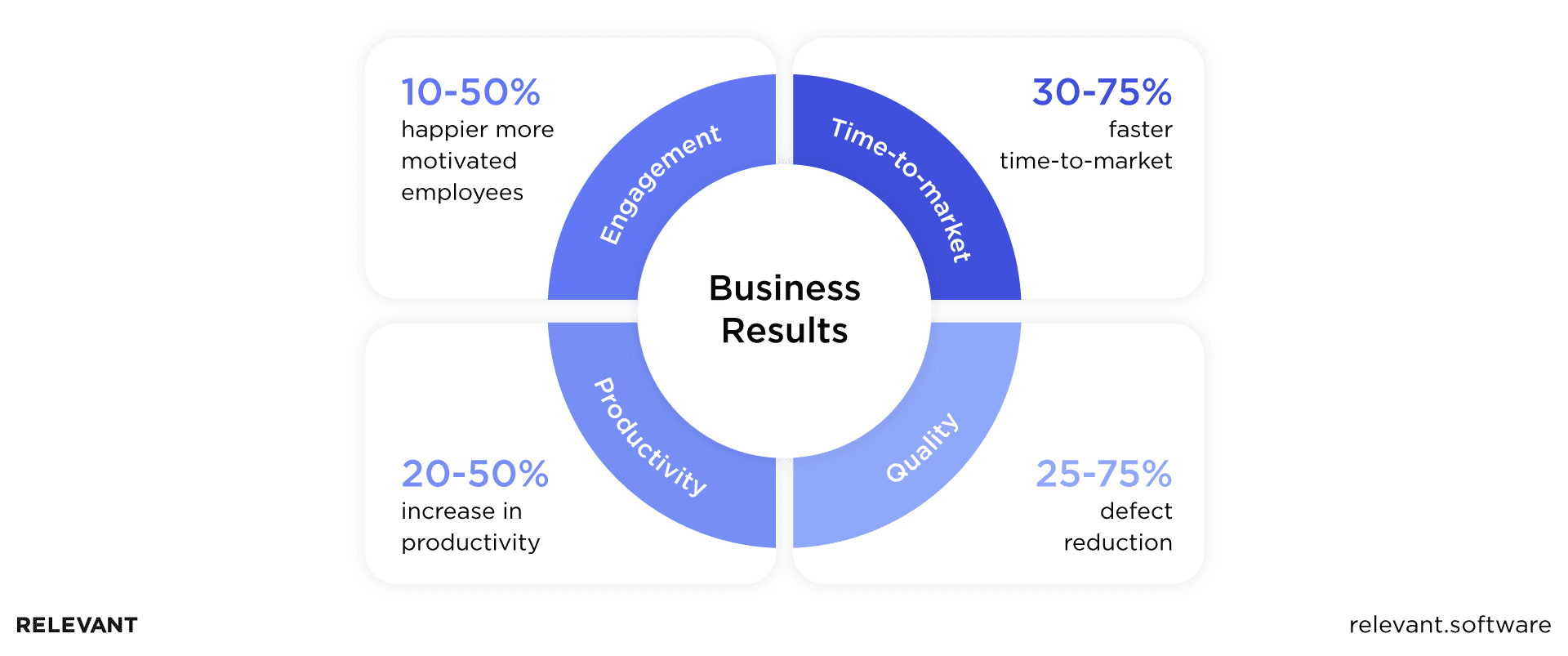
While the above figures look very attractive, your mileage may vary depending on the type and scale of your enterprise, as well as the kinds of inherent problems you need to fix. In the next section, we’ll provide some possible scenarios where you can win big from implementing SAFe.
When to use SAFe
Not every enterprise requires SAFe, but here are some telltale signs indicating that it might:
- You’re already working within the Agile practices, and there’s an immediate need for scaling up the teams, but you can’t predict the changes in roles.
- Several of your teams have developed internal dependencies and are delaying delivery for each other.
- You need to align product vision between enterprise and team level so that it can transform into value.
- Your distributed agile teams consistently run into synchronization issues or request more autonomy.
- You need to boost productivity and shorten the delivery time for a rapidly growing enterprise across multiple teams.
There may be a number of other reasons for a particular business to adopt the Scaled Agile Framework practices, but we wouldn’t recommend doing so without consulting a software partner with applicable experience.
And here’s another thought: before choosing to go with SAFe, consider other Agile scaling frameworks.
SAFe compared to other frameworks
A thorough comparison of the available Agile frameworks is a subject for another article, so we’ll keep it brief. Here are the frameworks and their most important features.
Scrum@Scale
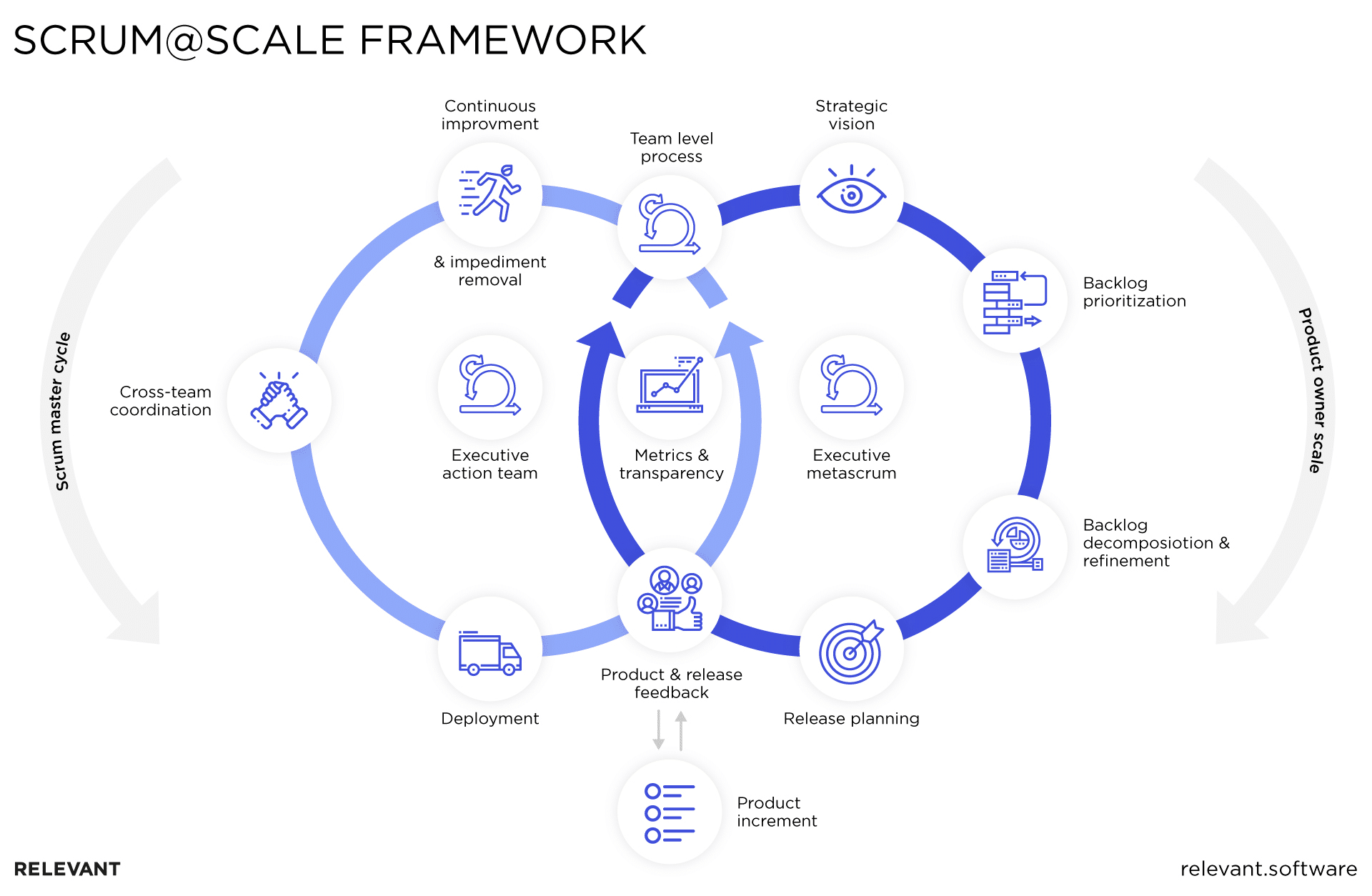
Born under the supervision of Dr. Jeff Sutherland, one of the co-authors of Scrum and the Agile Manifesto, this framework strives to reduce bureaucracy to the bare minimum and allow teams to scale organically and at their own pace. An Executive Action Team (EAT) is established as the ultimate authority when it comes to transformational decisions, priorities, and improvement.
Nexus
Another Scrum-based methodology, this framework is intended for three to nine teams that consist of three to nine people. By keeping everything compact and in check, the Nexus framework offers an excellent solution for smaller projects. All teams work on producing a common presentable increment at every sprint. Ideal for small and medium-sized projects, but not so much potential for scaling up further.
Disciplined Agile (DA)
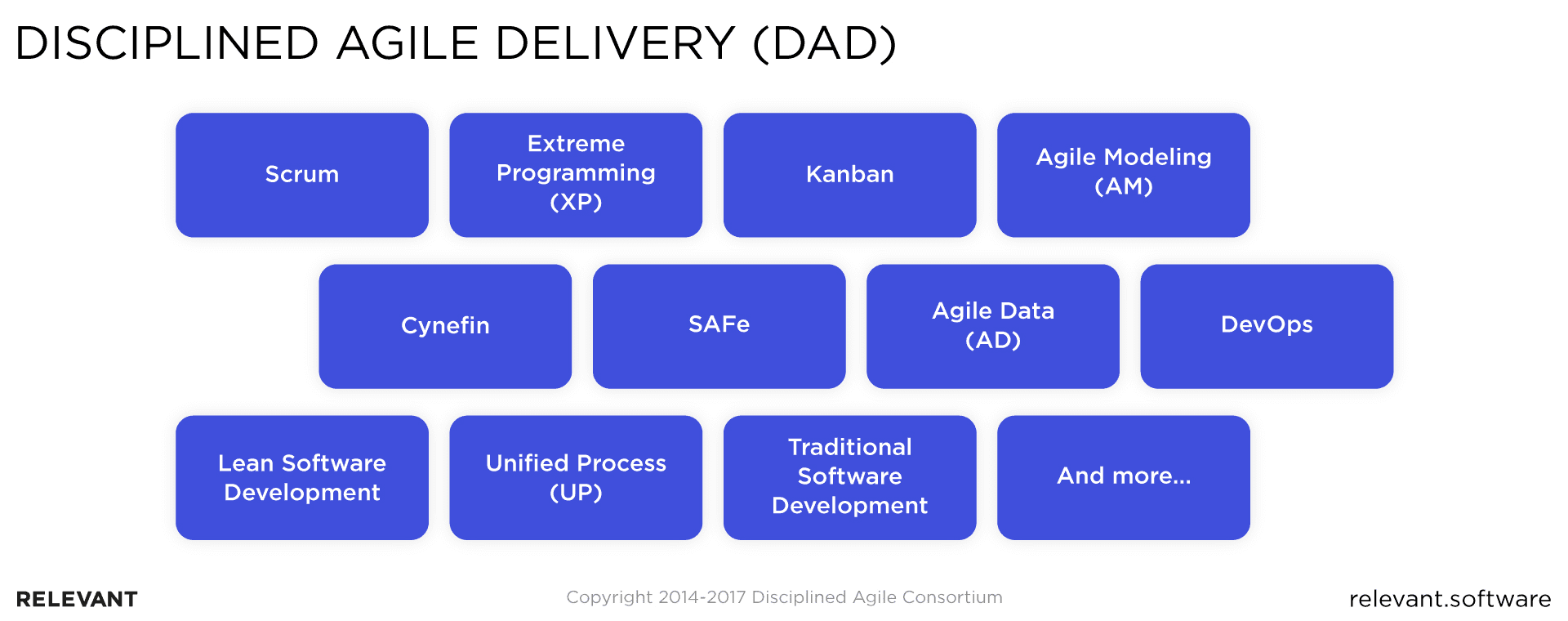
A hybrid approach, this framework focuses on full-cycle coordination of a company’s IT— from the development cycle to operations, support, and data management. However, this solution might not be the best choice at the first experience of adopting Agile, as it contains very basic guidance on this philosophy, and so will come with a learning curve.
LeSS
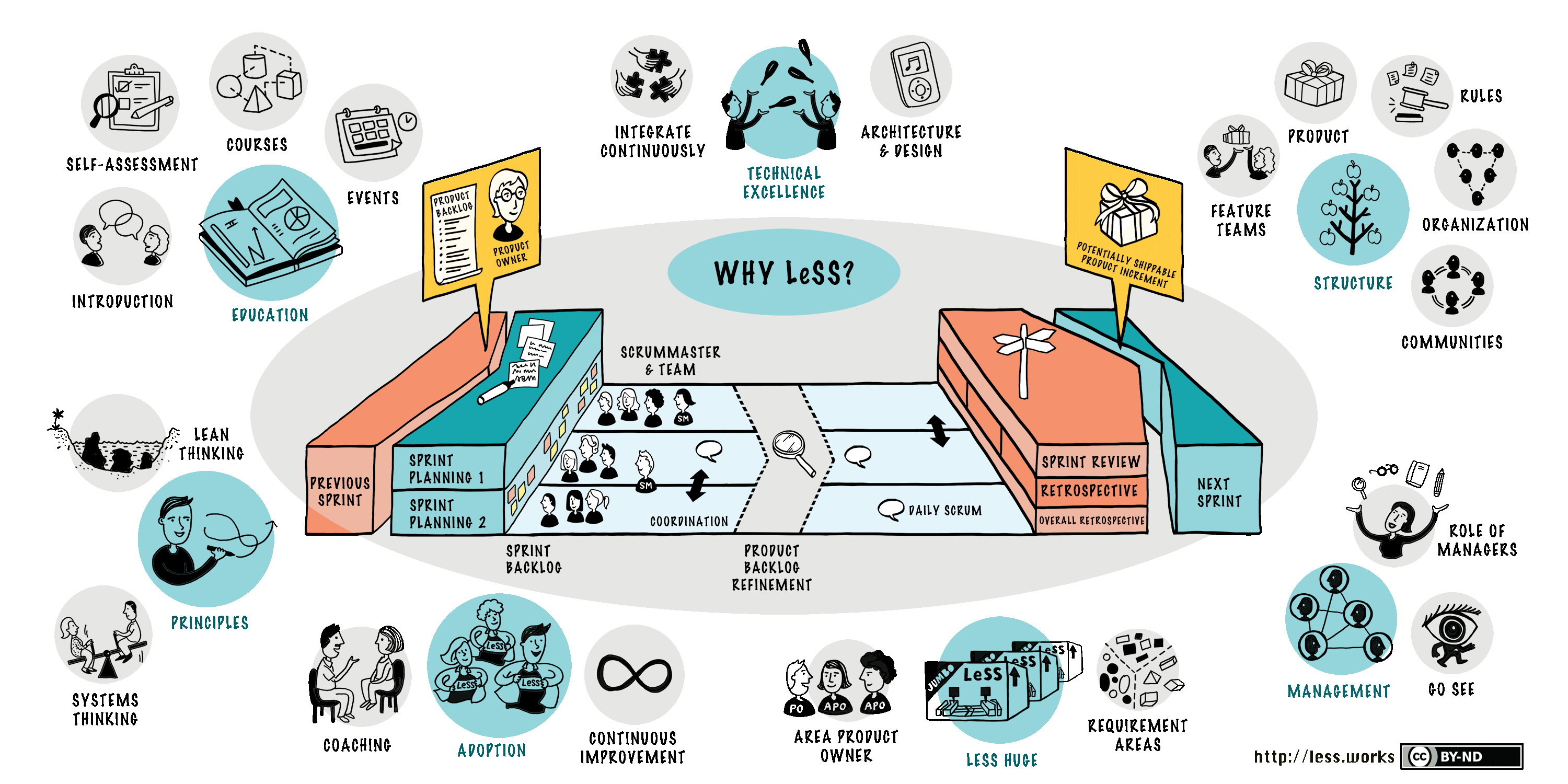
The Large-Scale Scrum (LeSS) framework is most efficient with scaling multiple teams that work on the same product. With its two configurations, Basic LeSS for two to eight teams (10-50 people) and LeSS Huge for over 6000 people, it introduces multiple changes to the standard scrum practices. For instance, teams in LeSS are cross-functional: in addition to developers and testers, they may include architects, UI/UX specialists, business analysts, and they must be able to develop both backend and frontend features. This provides for more autonomy and increased responsibility within teams.
Spotify Agile model
Although this is not an Agile framework per se, the Spotify agile model is worth mentioning because it represents a hugely successful enterprise and its take on implementing Agile methodology.
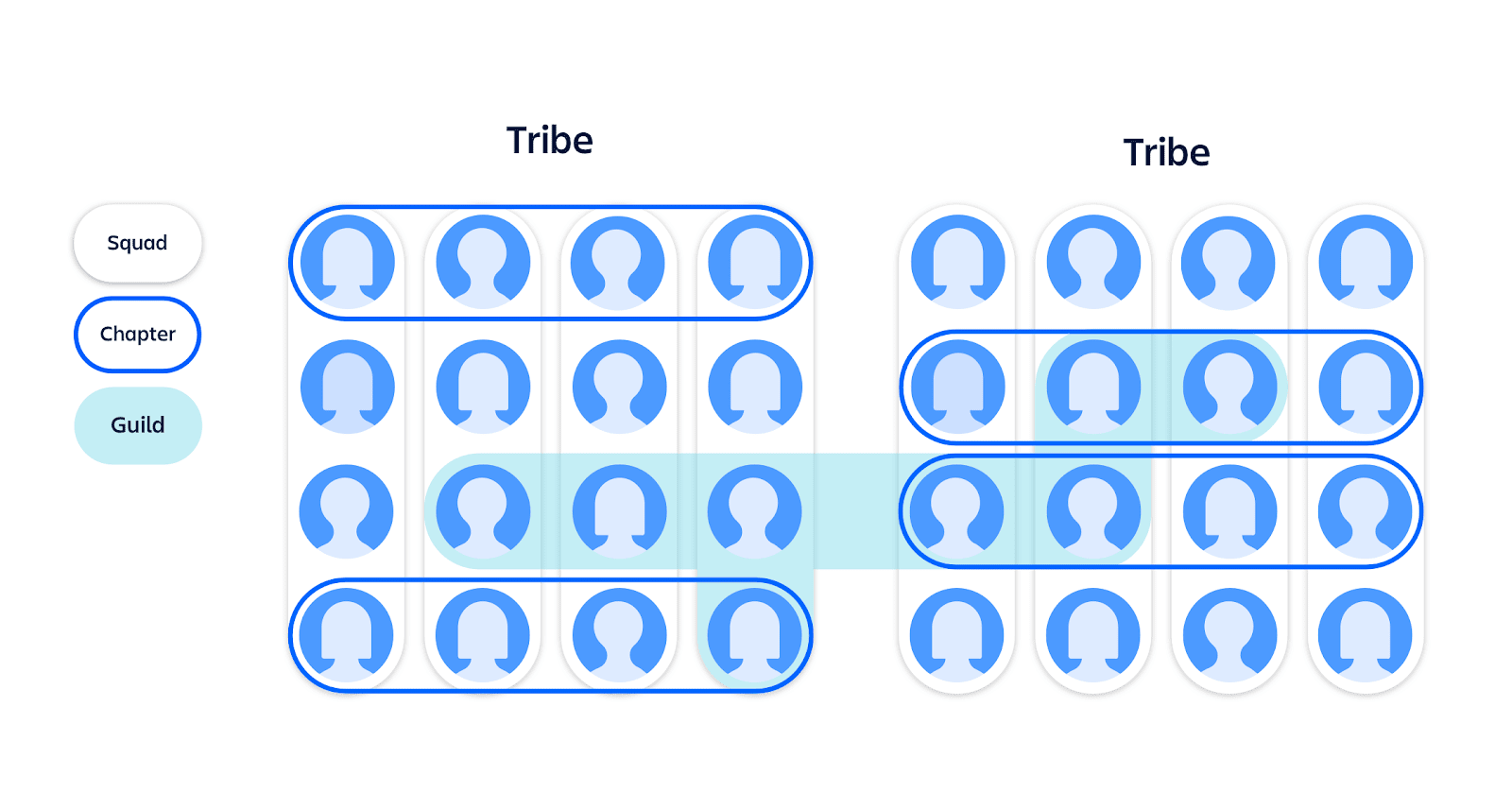
The division into Squads, Tribes, Chapters, and Guilds helps achieve autonomy and better communication within the organization while reducing formalities and ceremonies. However, this model might be challenging to adopt, as it was based on the company’s pre-existing internal culture, which isn’t something you can easily replicate.
These are some of the most popular Agile scaling frameworks. Each of them offers certain benefits for a particular use case and also presents challenges and requires significant time to implement. But let’s go back to our leading contender and see what the implementation process looks like.
How to implement SAFe
Important note: before an enterprise can adopt the SAFe approach, it needs to transition to the Lean Enterprise philosophy—and that takes time and systemic changes in policy and mindsets of the employees. Moving away from the more hierarchical structure of Waterfall is going to require a major commitment.
As you can see from the infographic below, the process consists of 12 steps and includes a lot of training, planning, and implementing new procedures. Unsurprisingly, the most drastic and lasting of changes will not occur overnight and will involve a long-term investment into the most valuable commodity—your employees.
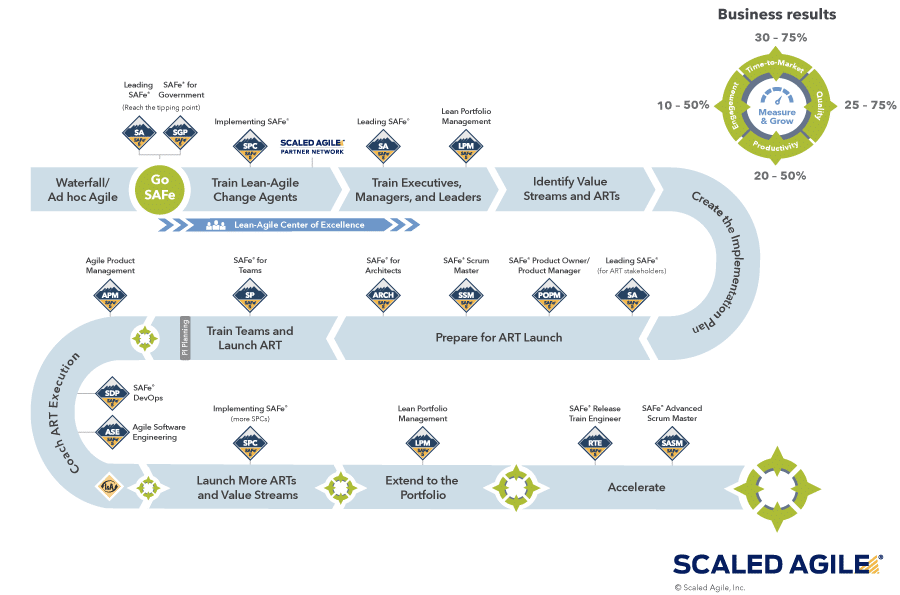
Want our advice? To ensure the transformation is rewarding and your gains exceed your losses, start your journey in the company of a trusted software partner. Oh, and keep your framework updated to the latest version.
What’s new in SAFe 5.0
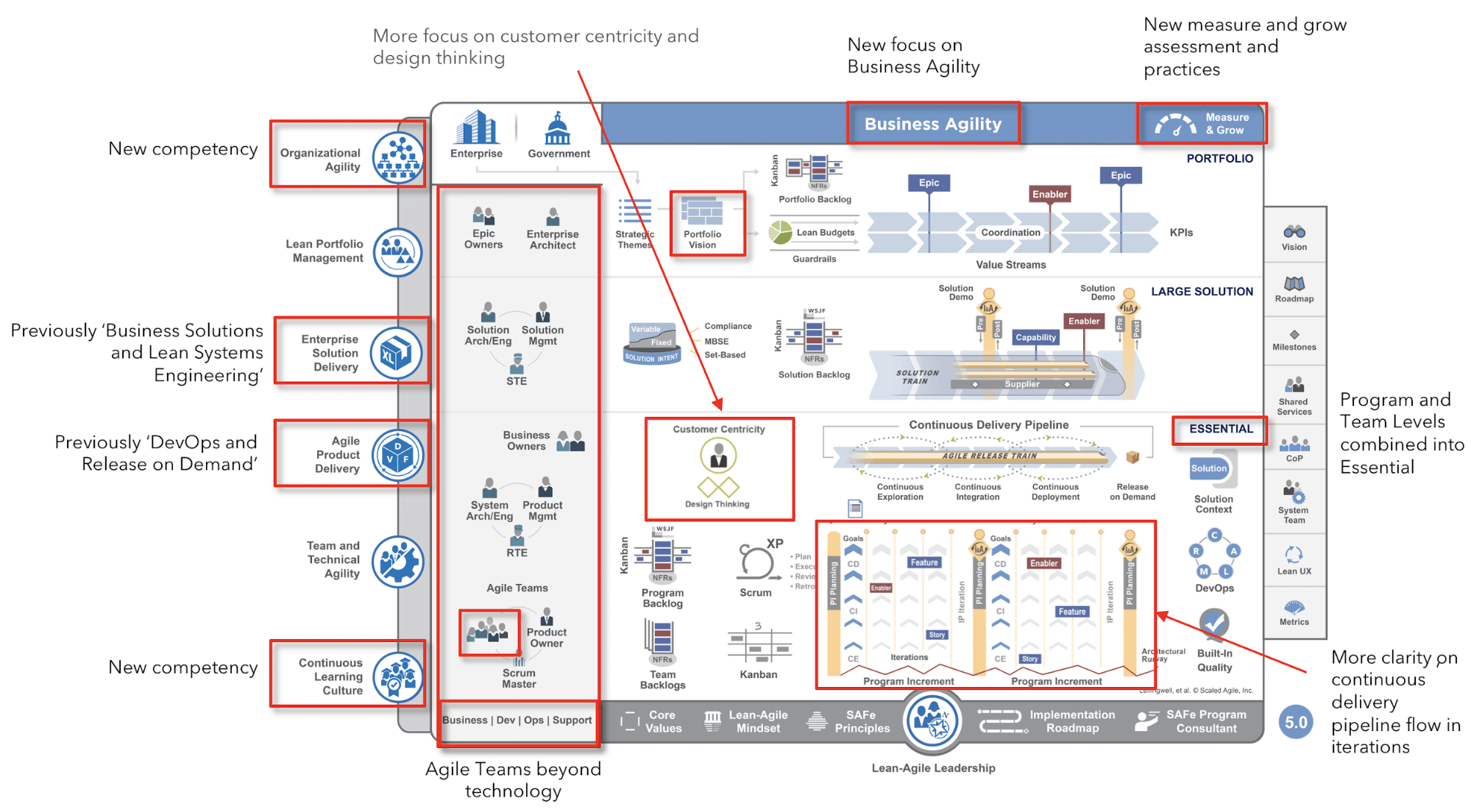
The newly released SAFe 5.0 contains important updates and refinements that reflect the current needs of today’s enterprises and ever-changing market demands. A simplified, more streamlined presentation concentrates on business agility and the steps necessary to achieve it, offers better structural clarity, and puts emphasis on customer-centricity as one of its core values. The authors point to the importance of competencies like Continuous Learning and Organizational Agility in the successful transformation and sustainable development of a SAFe-enabled enterprise.
If you’d like an even more detailed overview of the framework’s new version, feel free to visit the corresponding page on the project’s official website.
Relevant provides hand-selected tech talent to fit your needs at scale
Yes, we do, and we’re good at it. With over seven years in the field and multiple successful projects, Relevant has built a strong portfolio and lasting partnerships.
We have first-hand knowledge of the challenges your business may encounter, and we’ve accrued the tools and the expertise to facilitate your enterprise’s transition into a SAFe environment. Using our proven software development team structure, we will provide our skilled professionals right where and when you need them. Give your project a significant boost on its way to achieving business objectives. With Relevant’s top-class consultants, cybersecurity experts, and software architects, you can scale with confidence.



